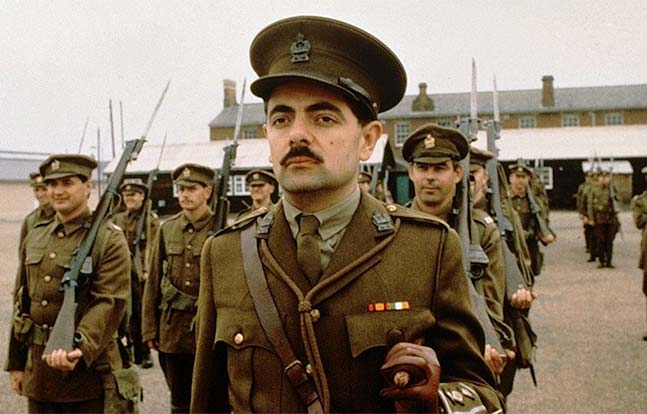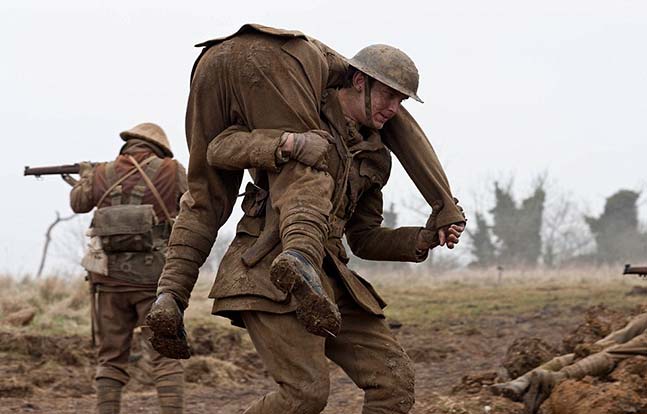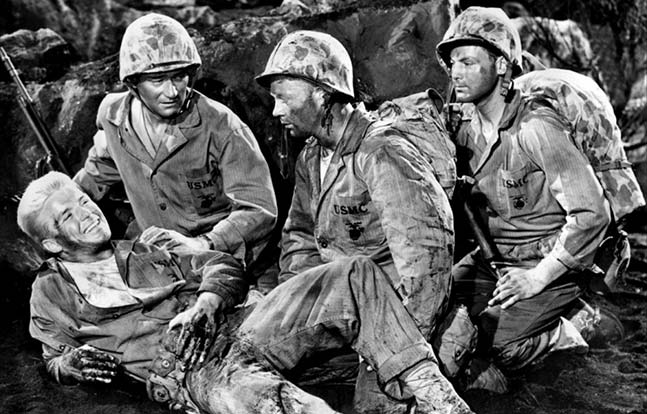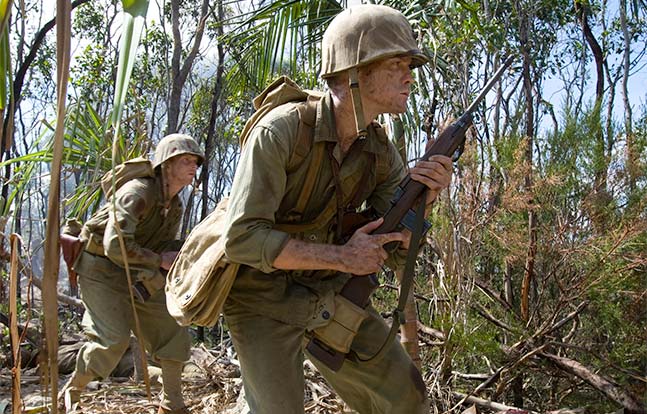It started in junior high school. Back in the 1970s, because the school didn’t want us out buying drugs on Friday nights, they would show a movie in the cafeteria. Of course, it was almost always a war movie—The Dirty Dozen, Kelly’s Heroes, Where Eagles Dare—I guess they figured they had historical value as well. Me? I was hooked on World War II movies after that, and the World At War Time-Life books that were just hitting the newsstands sealed the deal with cover headlines like “Blitzkrieg!”
RELATED: Remembering John Fasano
The only problem was that movies like The Dirty Dozen, which had Lee Marvin being assigned a dozen convicted criminals to train and lead on a mission to wipe out German officers, had characters armed solely with M3 “Grease Guns” against Nazi forces armed mostly with MP 40s, creating a battle between the WWII subguns. It wasn’t until I saw the movie Patton that I realized the M1 Garand—not the Thompson—was our main battle weapon in the war.
Advertisement — Continue Reading Below
For those who want to see classic wartime weapons in action there are many good options out there in today’s film world. A good example is 2001’s Enemy At The Gates, a gripping true-life story of two snipers going head to head during the Battle of Stalingrad. Jude Law plays Russian sniper Vassili Zaitsev and Ed Harris is German sniper Major Erwin König. The film has Law armed with a Mosin-Nagant 91/30 sniper rifle. He plays a game of cat-and-mouse with Harris’ König and his Mauser Karabiner 98K sniper rifle.
RELATED: Lights, Camera, GLOCKs: The Best of John Fasano
Another lost story of the war was dramatized in 2005’s The Great Raid. Towards the end of WWII, nearly 500 American soldiers had been captives in a Japanese POW camp for three years. Benjamin Law & Order Bratt, James Spider-Man Franco, Mark Legend of Butch and Sundance Consuelos and Joseph Enemy At The Gates Fiennes portray a force of Army Rangers and Filipino guerilla fighters. Armed with everything from M1903 Springfields to M1918 Browning Automatic Rifles, they set out to accomplish one of the greatest victories of the war. Fans of surplus Japanese arms will be glad to see a wealth of Nambu Type 14 pistols and Type 38 and 99 Arisaka rifles in the hands of the Japanese forces.
Advertisement — Continue Reading Below
Director Clint Eastwood even gave us the war in the Pacific from the Japanese point of view in Letters From Iwo Jima, his companion piece to Flags Of Our Fathers. Letters follows the Japanese soldiers through the course of the battle and features the full breadth of issue Imperial Navy and Army weapons, including Type 14 Nambus, “baby” Nambus, Arisaka 99 rifles and light and heavy machine guns. The U.S. forces in both films were armed with ’03 Springfields, M1 Carbines, M1A1 Thompsons and Garands.
“It wasn’t until I saw the movie Patton that I realized the M1 Garand—not the Thompson—was our main battle weapon in the war.”
While technical advisors have tried to keep Hollywood honest about the weapons of war, the film that changed it all in terms of battlefield realism was Steven Spielberg’s Saving Private Ryan, in 1998. The film’s brutal depiction of the Normandy Beach landings took war movies to the next level. After surviving the carnage of D-Day, a group of U.S. soldiers, including Tom Black Hawk Down Sizemore, Vin Fast & Furious Diesel and Barry The Green Mile Pepper as a left-handed sniper, are led by Tom Hanks’ Captain Miller behind enemy lines to retrieve a paratrooper—Matt The Bourne Identity Damon—whose brothers have all been killed in action.
Advertisement — Continue Reading Below
Real-World Firepower
Director/writer John Milius, of Red Dawn and The Wind And The Lion fame, always told me he wished that Saving Private Ryan had been even more realistic, claiming that in actuality they would have selected a couple of men from Ryan’s forward group to escort him back, giving them a real reason to gripe along the way in seeing their progress toward Berlin halted.
Milius’ own entry to the World War II genre is Farewell to the King. Based on a book by Pierre Schoendoerffer, this 1989 film featured British advance scouts Nigel Chariots Of Fire Havers and Frank 48 Hours McRae arriving on a Pacific Island to discover that U.S. Army deserter Nick Nolte has become “king” to a village of headhunters. The British want to use the village in the fight against Japanese forces occupying the nearby islands, and, like all Milius movies, there is an amazing arsenal used by the combined U.S., British and Australian troops, including Lee-Enfield No. 1 Mk IIIs, No. 5 Jungle Carbines, Stens, Thompsons, Bren Guns and the folding-stock M1A1 Carbine used by Havers as his primary weapon.
Advertisement — Continue Reading Below
But Milius’ greatest contribution to the concept of military surplus in Hollywood is a film he produced called Uncommon Valor. In this 1983 film, Gene Hackman gets together a small group of Vietnam vets to go into Laos and rescue POWs he believes are still being held there. While the group, which includes Fred Tremors Ward, Reb Brown and Patrick Road House Swayze, trains with modern M16, they find their weapons are all confiscated when they get to Asia. They then have to go to a shady arms dealer who sells them a dusty trunk of World War II weapons. This includes dusty, rusty M1 Garands and 1928 Thompsons, which they then have to clean and oil and, in a scene you’d only see in a Milius movie, sight them in. The rousing finale has them taking on the AK-47-wielding camp guards with “surplus arms”!
Director John Woo’s Windtalkers features two U.S. Marines in WWII who are assigned to protect Navajo Marines who use their native language as a radio cypher. This tale of the Battle for Saipan stars Nicolas Cage and Christian Slater armed with Thompson Model 1928A1 machine guns while the Native American code breakers carry M1 Carbines.
A wildly fictionalized version of WWII came in Quentin Tarantino’s Inglourious Basterds. This film, released in 2009, spins an “alternative history” version of Nazi-occupied France. Here a small squad of Jewish U.S. soldiers plans to assassinate Nazi leaders under the leadership of Brad World War Z Pitt. And, although Pitt’s men are armed with weapons like baseball bats, sawed-off double barrels and Bowie knives, when the shooting starts, the Garands, M3 “Grease Guns” and Thompson 1928A1s all make an appearance.
Advertisement — Continue Reading Below
One of the more recent entries is The Monuments Men, featuring George Clooney as director to an eclectic cast that includes John The Flintstones Goodman, Bill Ghostbusters Murray, Hugh Bonneville from Downton Abbey, and Cate Lord Of The Rings Blanchett. The Monuments Men is true story of an unlikely World War II platoon of soldiers (armed with M1 Garands) and art experts (toting M1 Carbines) who are tasked to rescue art masterpieces from Nazi thieves.
Small-Screen Surplus
Surplus arms haven’t been neglected on the small screen, either! Coming off the success of Saving Private Ryan, Tom Hanks and Steven Spielberg teamed up for the epic mini-series Band Of Brothers to tell the story of Easy Company, members of the U.S. Army’s 101st Airborne Division, from basic training through their mission in WWII Europe. Easy Co. takes on the Axis with the Thompson M1A1, the M3 “Grease Gun,” the M1 Garand, M1 Carbine and, of course, the 1911A1 pistol.
Advertisement — Continue Reading Below
After the huge success of Band Of Brothers, Hanks and Spielberg followed that up in 2010 with The Pacific, another massive 10-part mini-series telling the intertwined stories of three Marines, including the legendary John Basilone, during America’s battle with the Japanese in the Pacific during World War II. In the early episodes, the Marines fight with their issue Springfield 1903A3 rifles, later upgrading to Garand semi-autos. Of course, since this is set in the Pacific theater, the .30-caliber M1 Carbine comes into play against the Arisaka Type 38s used by the Japanese troops.
While American companies concentrate on WWII, British TV has a preference for dramas set during World War I. Sunday night PBS favorite Downton Abbey starts with the sinking of the Titanic in 1912. But this tale of English aristocracy quickly brings Upstairs, Downstairs-style drama into WWI, with season two having Matthew Crawley, played by Dan Stevens, fighting and being wounded in the trenches at Somme. And, when the wounded start returning to England, the Abbey itself is transformed into a rehabilitation center for the soldiers.
Enduring Legacy
Advertisement — Continue Reading Below
Whether it’s a historical drama like Clint Eastwood’s Letters From Iwo Jima or a BBC comedy like Rowan Atkinson’s Black Adder, the big and small screen will always have a place for the surplus arms. The guns that fought and won those wars are still as effective as they were nearly 100 years ago. So grab your Springfield 03A3 and settle down with a nice war movie.
EDITOR’S NOTE: We are sad to report that John Fasano passed away in his sleep on Saturday, July 19, 2014, at the age of 52. Fasano was a valued contributor to our magazines and will be sorely missed by all.













































